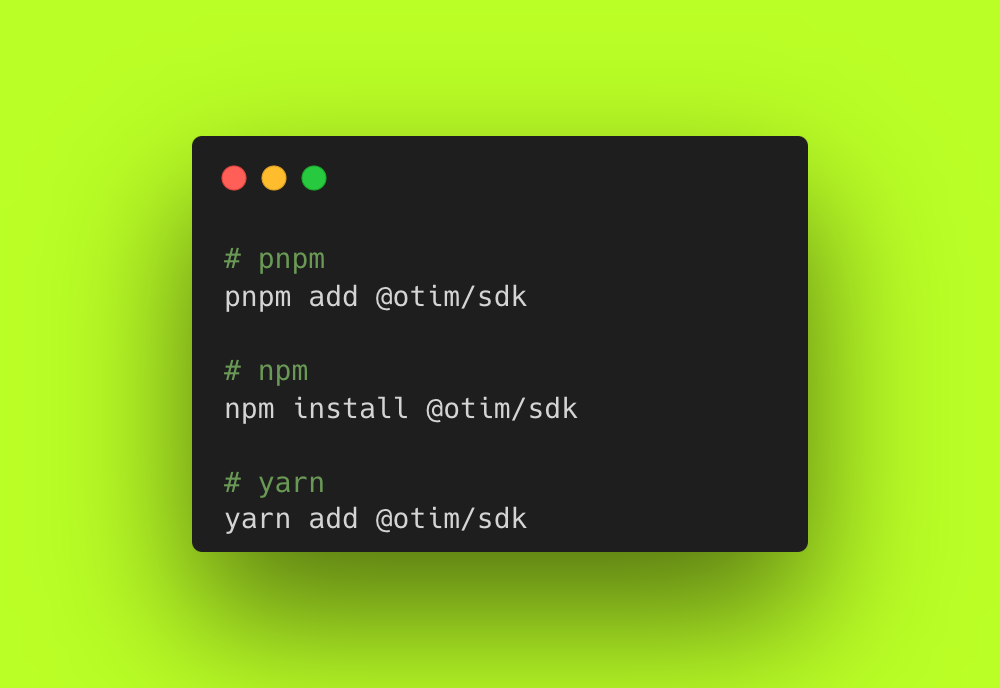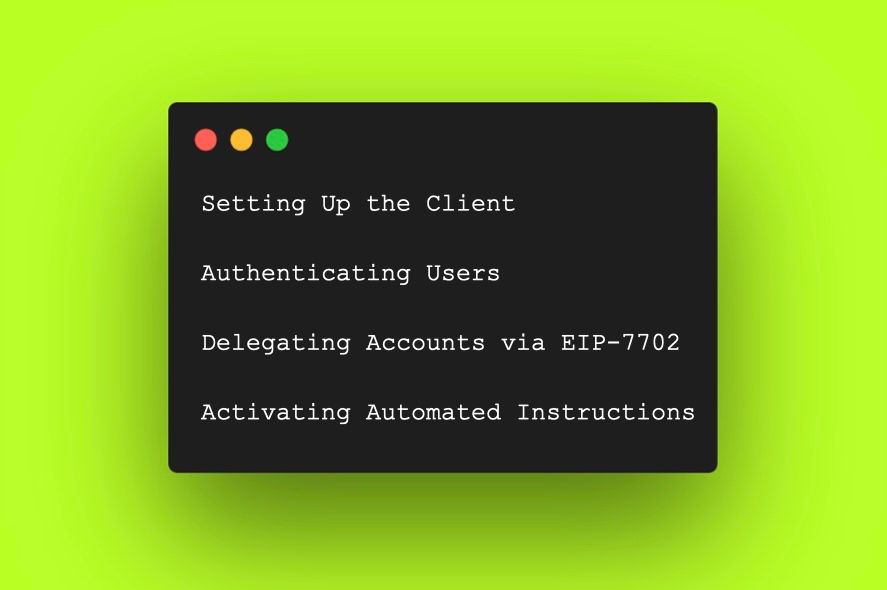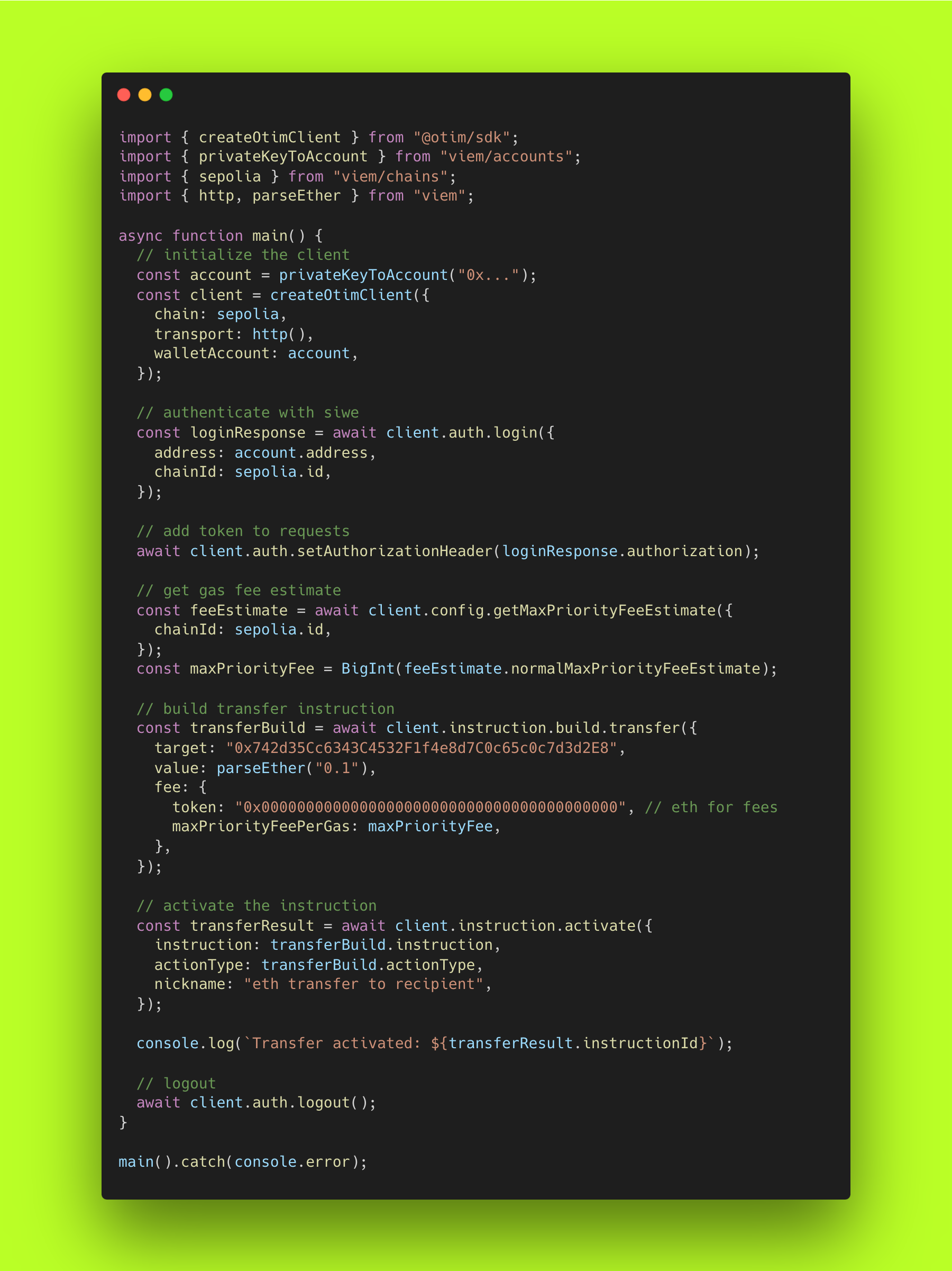Otim TypeScript SDK Beta: Build Trustless Automation in Less Than 10 Lines
We're excited to announce the beta release of the Otim TypeScript SDK v0.1! After months of development, we've built something we think developers will love: a way to add trustless automated executions to any app or wallet with less than 10 lines of code.
Julian Rachman

Here's the reality: adding automation features to Web3 applications has been a nightmare. Want to let users set up recurring payments? Hope you enjoy writing complex smart contracts. Need dollar-cost averaging? Get ready for months of development. Want compatibility across different wallets? Good luck.
The result is that most applications never implement automation features, even when they would massively improve user experience. Users are stuck manually executing the same transactions over and over again.

We decided to fix this.
What Makes This SDK Different
The Otim TypeScript SDK is built around four simple flows that handle everything you need for trustless automation:

Setting Up the Client
Dead simple initialization that works in both client-side and server-side environments. The SDK handles connection management, network configuration, and all the protocol details automatically.
Authenticating Users
Works with whatever wallet setup you already have. Injected wallets, embedded wallets, custom auth flows—doesn't matter. The SDK integrates with your existing authentication without requiring changes.
Delegating Accounts via EIP-7702
This is where the magic happens. EIP-7702 lets users delegate execution authority to smart contracts while maintaining full custody of their funds. The SDK abstracts away all the complexity, giving you simple methods that handle the underlying protocol interactions.
Unlike 4337 implementations that work as "permissioning" systems, Otim was designed with "pure intent" in mind. Instead of "allow recurring $10 payments to this address" (permissioning), users simply say "pay $10 recurring to this address" (pure intent). You're not giving permissions to a dapp to perform anything on your account as long as it meets certain criteria. You're directly expressing what you want to happen.
The delegation persists and can be updated at any time. You can change which contract your account is delegated to whenever you want, and the code remains attached to your EOA until you choose to change it.
Activating Automated Instructions
Once delegation is complete, users can create "instructions"- automated rules that define when and how actions should happen:
- Subscriptions: Set up recurring payments for your SaaS without building billing infrastructure
- Dollar-Cost Averaging: Regular token purchases on autopilot
- Balance Top-ups: Automatically refill accounts when they fall below certain thresholds
- Yield Optimization: Harvest and reinvest rewards automatically
- Cross-Chain Operations: Bridge assets and manage positions across networks
The beauty is in the simplicity. Complex automation strategies become simple configuration.
Built on Battle-Tested Infrastructure
We built the SDK on top of Viem, and there's a good reason for that. Viem has become the gold standard for Ethereum interactions in TypeScript. It's fast, reliable, and used by thousands of applications.
By building on Viem, we get:
- Full TypeScript support with comprehensive type definitions
- Optimized performance and minimal bundle size
- Rock-solid reliability that's been battle-tested
- Seamless integration if you're already using Viem
If you're not using Viem yet, the SDK still works perfectly, but you might find yourself wanting to switch after seeing how smooth the developer experience is.
Less Than 10 Lines of Code
Here's what makes us most excited: a complete end-to-end automation setup can be implemented in fewer than 10 lines of functional code (excluding imports and formatting).
This isn't marketing speak or hidden complexity. The SDK provides sensible defaults, intelligent configuration detection, and error handling that eliminates the boilerplate typically required for blockchain integrations.
You can literally fit a working automation integration in a single screenshot.

Works with Every Wallet Provider
One of our favorite features is universal compatibility. The SDK works seamlessly with embedded wallet providers like Turnkey, Privy, Dfns, Dynamic, Para, Openfort, and many others.
This means you don't need to rethink your wallet strategy to add automation. The SDK extends what you're already building rather than replacing it. Your users keep the wallet experience they're familiar with, and you get powerful automation features on top.

Security is Built-In
Trustless automation means users never lose custody of their funds. Every automation operates through the pure intent model we described earlier. Users express exactly what they want to happen, not what they’re allowing to happen.
Every automated execution is fully auditable onchain, and delegation can be updated or revoked instantly. This gives users complete transparency and control while enabling powerful automation features.
For more details on our security model, check out our technical documentation where we dive deep into the architecture and design decisions that make this possible.
What You Can Build
The SDK opens up possibilities across different types of applications. Here are some ideas to get you started:
- SaaS applications can implement automatic recurring payments without building complex billing infrastructure
- Enterprise solutions can handle payroll and treasury operations with full audit trails
- DeFi protocols can offer automated strategies like dollar-cost averaging, yield farming and rebalancing
But these are just starting points. The real innovation will come from what you build with these tools.
Join Our Community
We're looking for developers who want to explore what’s possible with trustless automation.
Join our Telegram community at https://t.me/otimlabs to jam with our team and other developers building on Otim OS. Whether you're debugging an integration, exploring new use cases, or just brainstorming automation possibilities, we're right there with you.
Check out the SDK documentation at https://docs.otim.com/sdk/overview for comprehensive guides and integration examples.
Grab the package from NPM at https://www.npmjs.com/package/@otim/sdk and start building.
The future of account automation should be trustless, simple, and developer-friendly. With this SDK, that future is available today.
Let's see what you build with it. 📟 shipit.